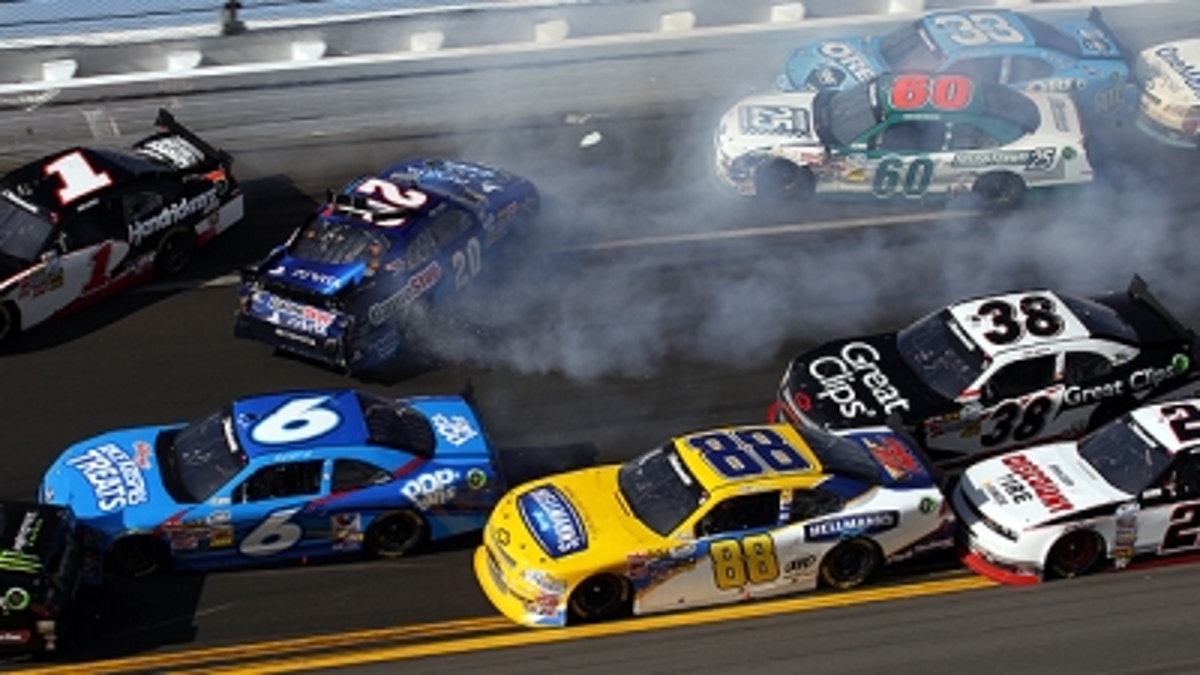
Brad Keselowski says he’s “most nervous” about the final lap of Sunday’s Daytona 500.
After witnessing the 11-car melee coming out of Turn 4 in Saturday’s Drive4COPD 300 before finishing the race in second place, Keselowski believes “the most dangerous aspect of our sport” is the timeliness of NASCAR flying the yellow flag to stop the action on the track.
“If you're running 25th, five or six seconds behind the pack when the wreck happened, the yellow didn't come out for about six seconds, from what I can estimate,” Keselowski said. “Obviously, there's a lot of tension in that area. I'm pretty sure it was seen. So the question is, ‘What's the appropriate amount of time?’ I think it's very much a judgment call.
“We saw it with the wreck in, I think it was the Shootout. I think I would rather see the sport lean to the cautious side. It's tough for NASCAR, obviously, to wave the yellow early and then take all the criticism from fans that didn't see their driver win if the yellow wouldn't have come out that early. So I can see that side of it. “
Keselowski was adamant that his comments were not an attempt to lobby for the win. And since NASCAR established its policy of no racing back to the caution in 2003 – feeling the necessity of more than just a gentlemen’s agreement to enforce the practice – it hasn’t been an issue.
Elliott Sadler remembers one of the earliest catalysts for the rule.
“The thing that stands still in my mind, some of you may remember it, is Dale Jarrett sideways on Turn 4 in New Hampshire, almost getting T-boned in the door,” Sadler said. “That's kind of when racing back to the caution went away in our sport. Forty-three very happy race car drivers stood up and applauded NASCAR for making that change. It's definitely a safety issue.
“You're going to be on the receiving end of that rule sometimes and you're going to be on the bad end of it. It's a full rotation, a full circle. As far as the safety of our sport, I'm glad we have no racing back, the field is frozen. It's still a gray area. I'm glad I'm not pushing the button. Push it too early, you should have let them race. Sometimes you push it too late.”
However, drivers are going to race to the line when the yellow flag isn’t displayed swiftly enough. And that’s when the problems – and accidents – begin.
“When I look at the sport and I look at the most dangerous frontier, it's not the next head-and-neck system, it's getting hit from a car who is six or seven seconds from a wreck but has to keep going because the yellow is not out,” Keselowski said. “It eventually will happen where they'll hit a very slow car at a very high rate of speed and it will not be good.
“That's an area that is still maybe loosely defined and I'm not sure how to define it because I understand the difficulties that remain in that area to make those decisions. It's something that I go into the 500 - when I think what I'm most nervous about, I'm most nervous about the last lap, being at the front (of the) pack, being wrecked and stopped in the middle of the field, and some guy from 35th, knowing that the yellow is not going to come out for another six seconds, you know, whaling me going 180 while I'm going 5 or 10, or when I'm maybe stopped. That's certainly an area that I think about, for sure.”
The way Keselowski sees it, there’s a balancing act for drivers in the sport. Especially when it comes to restrictor-plate races.
Ones in which drivers are going all-out for the wins.
“I feel like we walk a line in this sport between daredevils and chess players,” Keselowski said. “When we come to Daytona, tracks like this, where maybe we're more on the daredevil side, then we go some other places where I'd say we're more on the chess-player side of the line.
“I think it's important to have tracks like this that maybe average it back out a little bit. Ideally we'd like to walk straight on the line all the time. But, you know, from a standpoint of the sport, the health of it, I think not a lot of people watch chess matches. I've never seen one televised. Maybe I turned the channel and never watched it. Not very exciting.”
The key for drivers is balancing those two aspects of the sport.
“Certainly being a daredevil is something completely different, as well,” he said. “I think it takes that fine line. I think we have to walk it all the time. We're probably a little bit to the left of the line when we come to these places. But you know what, I'm OK with that. I feel as it averages out, we walk it pretty well.”
On Saturday, there were only 17 cars running on the lead lap at the finish of the race. Kyle Busch and defending Nationwide Series Ricky Stenhouse Jr. took the white flag but following the wreck, never made it to the finish line.
So what’s Keselowski’s prediction for Sunday after experiencing the Budweiser Shootout, the Gatorade Duels, sustaining damage on his own truck Friday night during the second green-white-checker in the NextEra Energy Resources 250 and Saturday’s Nationwide romp?
“I think the end will look very similar to what you saw today,” Keselowski said. “We'll see who wins the lottery.”
